Long-Term Survival and Dialysis Dependency Following Acute Kidney Injury in Intensive Care: Extended Follow-up of a Randomized Controlled Trial
Background:
The incidence of acute kidney injury (AKI) is increasing globally and it is much more common than end-stage kidney disease. AKI is associated with high mortality and cost of hospitalisation. Studies of treatments to reduce this high mortality have used differing renal replacement therapy (RRT) modalities and have not shown improvement in the short term. The reported long-term outcomes of AKI are variable and the effect of differing RRT modalities upon them is not clear. We used the prolonged follow-up of a large clinical trial to prospectively examine the long-term outcomes and effect of RRT dosing in patients with AKI.
Methods and Findings:
We extended the follow-up of participants in the Randomised Evaluation of Normal vs. Augmented Levels of RRT (RENAL) study from 90 days to 4 years after randomization. Primary and secondary outcomes were mortality and requirement for maintenance dialysis, respectively, assessed in 1,464 (97%) patients at a median of 43.9 months (interquartile range [IQR] 30.0–48.6 months) post randomization. A total of 468/743 (63%) and 444/721 (62%) patients died in the lower and higher intensity groups, respectively (risk ratio [RR] 1.04, 95% CI 0.96–1.12, p = 0.49). Amongst survivors to day 90, 21 of 411 (5.1%) and 23 of 399 (5.8%) in the respective groups were treated with maintenance dialysis (RR 1.12, 95% CI 0.63–2.00, p = 0.69). The prevalence of albuminuria among survivors was 40% and 44%, respectively (p = 0.48). Quality of life was not different between the two treatment groups. The generalizability of these findings to other populations with AKI requires further exploration.
Conclusions:
Patients with AKI requiring RRT in intensive care have high long-term mortality but few require maintenance dialysis. Long-term survivors have a heavy burden of proteinuria. Increased intensity of RRT does not reduce mortality or subsequent treatment with dialysis.
Trial registration:
www.ClinicalTrials.gov NCT00221013
Please see later in the article for the Editors' Summary
Published in the journal:
Long-Term Survival and Dialysis Dependency Following Acute Kidney Injury in Intensive Care: Extended Follow-up of a Randomized Controlled Trial. PLoS Med 11(2): e32767. doi:10.1371/journal.pmed.1001601
Category:
Research Article
doi:
https://doi.org/10.1371/journal.pmed.1001601
Summary
Background:
The incidence of acute kidney injury (AKI) is increasing globally and it is much more common than end-stage kidney disease. AKI is associated with high mortality and cost of hospitalisation. Studies of treatments to reduce this high mortality have used differing renal replacement therapy (RRT) modalities and have not shown improvement in the short term. The reported long-term outcomes of AKI are variable and the effect of differing RRT modalities upon them is not clear. We used the prolonged follow-up of a large clinical trial to prospectively examine the long-term outcomes and effect of RRT dosing in patients with AKI.
Methods and Findings:
We extended the follow-up of participants in the Randomised Evaluation of Normal vs. Augmented Levels of RRT (RENAL) study from 90 days to 4 years after randomization. Primary and secondary outcomes were mortality and requirement for maintenance dialysis, respectively, assessed in 1,464 (97%) patients at a median of 43.9 months (interquartile range [IQR] 30.0–48.6 months) post randomization. A total of 468/743 (63%) and 444/721 (62%) patients died in the lower and higher intensity groups, respectively (risk ratio [RR] 1.04, 95% CI 0.96–1.12, p = 0.49). Amongst survivors to day 90, 21 of 411 (5.1%) and 23 of 399 (5.8%) in the respective groups were treated with maintenance dialysis (RR 1.12, 95% CI 0.63–2.00, p = 0.69). The prevalence of albuminuria among survivors was 40% and 44%, respectively (p = 0.48). Quality of life was not different between the two treatment groups. The generalizability of these findings to other populations with AKI requires further exploration.
Conclusions:
Patients with AKI requiring RRT in intensive care have high long-term mortality but few require maintenance dialysis. Long-term survivors have a heavy burden of proteinuria. Increased intensity of RRT does not reduce mortality or subsequent treatment with dialysis.
Trial registration:
www.ClinicalTrials.gov NCT00221013
Please see later in the article for the Editors' Summary
Introduction
Acute kidney injury (AKI) is approximately ten times more common than end-stage kidney disease [1], and the incidence is increasing worldwide [2],[3]. Short-term mortality rates of patients with AKI are in excess of 40%, predominantly in those who require renal replacement therapy (RRT) [4].
The longer term outcomes of patients with AKI are less clear. Existing descriptions of these outcomes have used variable methodologies and have been obtained from retrospectively defined cohorts. Whilst some have been population-based cohorts [5],[6], many have been based upon specific disease groups [7]–[9]. In addition, the AKI cohorts are often defined using post-AKI exposure data, such as hospitalization coding [10] or based upon survival of the acute hospitalization [6]. For clinicians, when managing patients presenting with AKI, these factors limit the applicability of these studies.
Following an episode of AKI, the balance of the risks of mortality and that of subsequent chronic kidney disease (CKD) remains uncertain. A recent meta-analysis by Coca and colleagues [11] reported absolute rates of CKD following AKI approximately 50% higher than that for mortality, but was limited by a high degree of statistical heterogeneity. A large population cohort study in 2009 concluded that AKI necessitating in-hospital dialysis was associated with an increased risk of chronic dialysis but not an increase in all-cause mortality [5].
Patients with AKI managed in an intensive care unit (ICU) often require RRT and have the highest short-term mortality of any group with AKI [4]. Studies that have examined different dose intensities of RRT have not demonstrated improvements in short-term outcomes [12]. Longer term outcomes of patients treated with different intensities of RRT are unknown.
We previously conducted a randomized-controlled trial comparing higher and lower intensities of continuous RRT [13] in ICU patients with AKI and demonstrated no difference in all-cause mortality at 90 days between the two groups. The aim of this study was to extend follow-up to up to four years and report longer-term mortality (along with the variables that may predict mortality), treatment with chronic dialysis, and functional outcomes in patients treated with different intensities of continuous RRT.
Methods
Study Design
A description of the Randomized Evaluation of Normal vs. Augmented Levels of renal replacement therapy (RENAL) study design has been previously published [14]. In brief, it was a parallel group, open-label, randomized-controlled trial in 1,508 ICU patients with AKI requiring RRT from 35 centres in Australia and New Zealand between December 2005 and August 2008. Patients in ICU aged 18 or older, deemed by the treating clinician to require RRT and meeting at least one of the following criteria, were eligible for enrolment: oliguria (urine output < 100 ml in a 6-hour period) that was unresponsive to fluid resuscitation, serum potassium exceeding 6.5 mmol per litre, severe acidaemia (pH<7.2), a plasma urea nitrogen above 25 mmol per litre (70 mg per decilitre), a serum creatinine concentration above 300 µmol per litre (3.4 mg per decilitre), or the presence of clinically significant organ oedema (e.g., pulmonary oedema). Eligible patients were randomly assigned to receive 25 ml/kg/h (lower intensity) or 40 ml/kg/h (higher intensity) of continuous haemodiafiltration and were followed to 90 days after randomization. Study treatment was ceased when any of five pre-defined criteria were met: withdrawal of consent, death, discharge from ICU, when intermittent dialysis was considered preferable to continuous RRT for the patient, or when the treating clinicians considered that RRT was no longer required.
The Prolonged Outcomes Study of RENAL (POST-RENAL) was an investigator-initiated, prospective, extended follow-up of the RENAL study, funded by a project grant from the Australian National Health and Medical Research Council. The study was designed and managed by the study management committee and endorsed by the Australia and New Zealand Intensive Care Society Clinical Trials Group. The study protocol was approved by human research ethics committees at each of the participating centres and centrally by the Australian Institute for Health and Welfare Ethics Committee. Statistical analyses were conducted at the George Institute for Global Health.
Study Participants
All participants in the RENAL study were included in the primary and secondary outcomes of the POST-RENAL study. Tertiary outcomes were obtained in the subset of consenting survivors. Ethics committee approval granted a waiver of the requirement for individual consent to link to state and national registries, whereupon survivors were approached for written informed consent to participate in the collection of the tertiary outcomes for the POST-RENAL study.
Follow-up
Using the RENAL Study database, we identified all participants alive at day 90 following randomization. The initials and study numbers of these participants were provided to all the participating centres who then added patient identifiers to these data. These data were then used to link to mortality registries in all Australian states and nationally in New Zealand, along with the Australia and New Zealand Dialysis and Transplant (ANZDATA) Registry. In addition, study centres used medical records along with contact details to ascertain the survival and dialysis status of patients.
The following registries were accessed to contribute to the primary and secondary outcomes of the POST-RENAL study: Data Linkage Unit, Australian Institute of Health and Welfare National Death Index, Canberra, Australia (accessed July 2010, October 2010, January 2011, and September 2011); NZ Births, Deaths and Marriages Registry, Department of Internal Affairs, Wellington, New Zealand; Victorian Registry of Births, Deaths and Marriages, Victoria, Australia (accessed October 2010 and January 2012); Research and Statistics, Department of Justice, Queensland, Australia (accessed October 2010 and July 2011); NSW Registry Births Deaths and Marriages, New South Wales, Australia (accessed October 2010, April 2011 and October 2011); WA Registry of Births, Deaths and Marriages, Western Australia, Australia (accessed October 2010); Consumer and Business Services, Births, Deaths and Marriages Registration Office, South Australia, Australia (accessed October 2011); Births, Deaths and Marriages – ACT, Australian Capital Territory, Australia (accessed October 2011); Australia and New Zealand Dialysis and Transplant (ANZDATA) Registry, South Australia, Australia (accessed March 2011 and January 2012).
Outcome Measures
The primary outcome measure was all-cause mortality 3.5 years after randomization. This measure was assessed by follow-up from the study centres and by linking to state and national death registries. Causes of death were independently adjudicated by two medical practitioners from death certificate data, with consensus arrived at for any discrepant classifications. The secondary outcome was treatment with maintenance dialysis (defined as entry to a chronic dialysis program and meeting criteria for inclusion in the national dialysis registry) during the 3.5 years following randomization. Information on maintenance dialysis was obtained by follow-up from the study centres and by linkage to the Australian and New Zealand Dialysis and Transplant (ANZDATA) Registry.
Tertiary outcomes were quantification of renal function in survivors determined by serum creatinine and estimated glomerular filtration rate (eGFR) using the Modification of Diet in Renal Disease Study Group (MDRD) formula [15]; prevalence of proteinuria measured by spot urinary albumin to creatinine ratio (ACR); blood pressure and receiving treatment to lower blood pressure; quality of life using the EuroQol Group 5 dimension tool (EQ-5D) [16]; and the 12 variable Short Form Health Survey (SF-12) [17]. EQ-5D derives a score after assigning the worst imaginable health state a value of 0 and the best imaginable health state a value of 1, although it does permit negative scores. SF-12 uses eight domains, with scores ranging from 0 to 100, that allow aggregation into physical health and mental health composite scores, with higher scores representing better quality of life.
Quality of life was assessed by telephone interviewers based at the George Institute for Global Health; the interviewers were blinded to original study treatment allocation.
Baseline characteristics of the study population included demographic and laboratory variables, the presence of sepsis (defined by the presence of a focus of infection and two systemic inflammatory response syndrome criteria [18] within 24 hours following randomization), the Acute Physiology and Chronic Health Evaluation (APACHE) III score (a severity of illness score ranging from 0 to 299, with higher scores indicating more severe illness [19]), and the Sequential Organ Failure Assessment (SOFA) score (ranging from 0 to 4 for each of six organ systems with higher scores indicating more severe organ dysfunction) [20].
Statistical Analysis
The analysis followed a statistical analysis plan developed prior to any analysis of the study data (see Text S1). The dialysis-free days outcome from this plan is presented in Table S1. The data were analysed using SAS version 9.2. Where data were missing, we report the number of available observations and make no assumptions about missing values. Analyses were unadjusted, except where indicated. All tests were two-sided with a nominal value of α = 0.05. Discrete variables were summarised by frequencies and percentages; continuous variables by mean and standard deviation (SD) or median and interquartile range (IQR) where appropriate. Univariate analysis was performed using chi-square tests for binary outcomes and Student t-tests for normally distributed outcomes.
The long-term survival was analysed according to two approaches: (1) from the time of patient randomization into the RENAL study, (2) from 90 days following randomization into the RENAL study (the final follow-up point for the RENAL Study). Data were censored at the time when the patient was last known to be alive. Survival curves and estimated median survival time (if available) and 95% confidence interval were generated according to the Kaplan-Meier method. The log-rank test was used to assess the difference between the two survival curves. Mortality beyond 90 days following randomization underwent multivariate analysis using Cox modelling using backward stepwise regression for variable selection (eliminating variables with p-values >0.05) and forced inclusion of the RENAL study treatment variable.
As death and chronic dialysis treatment are competing risks, a competing risk sensitivity analysis was performed between the two events. This analysis was based on the cumulative incidence function (CIF) and Gray's test to test the difference between the CIFs [21].
Results
Study Patients
Of the 1,508 patients randomized, 810 patients survived to day 90 after randomization (Figure 1), with 552 of these survivors (68%) alive at the time of the POST-RENAL study. Tertiary outcomes were available on 350 (63%) of these survivors who consented to follow-up between August 2010 and January 2012.
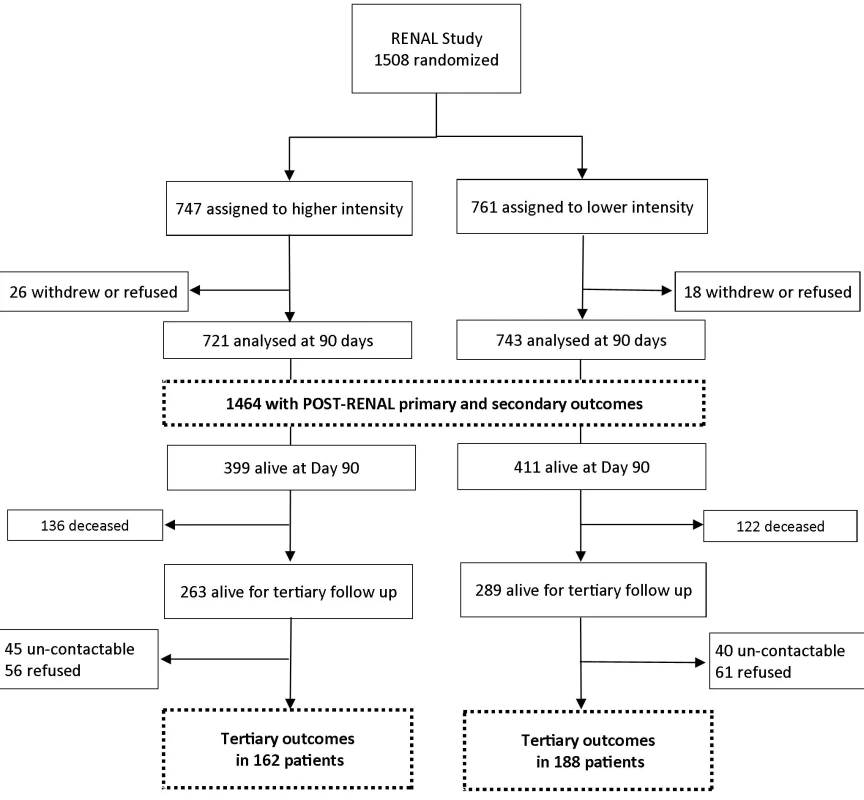
The baseline characteristics of all RENAL Study participants have been previously reported, and those of the 810 survivors at day 90 and of the 350 consenting to clinical follow-up are presented in Table 1.
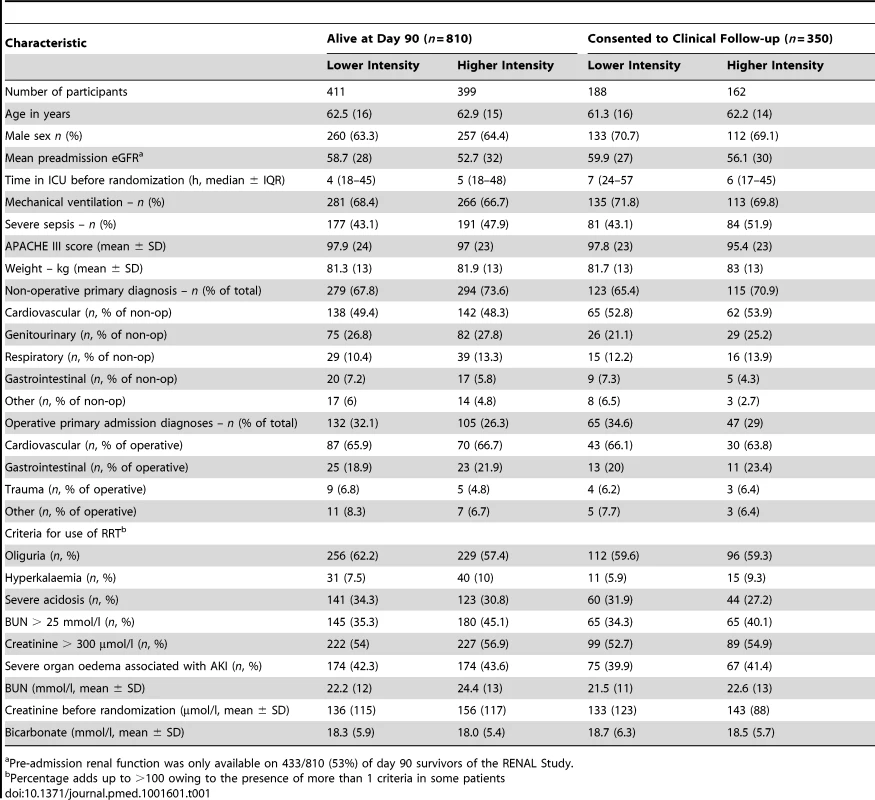
Outcomes
Primary and secondary outcomes were derived at a median of 42.4 months (IQR 30.0–48.6 months) post randomization. There were a further 258 deaths during the POST-RENAL study (122 in the lower intensity group, 136 in the higher intensity group), giving an overall mortality rate of 62% in the study cohort (Figure 2).
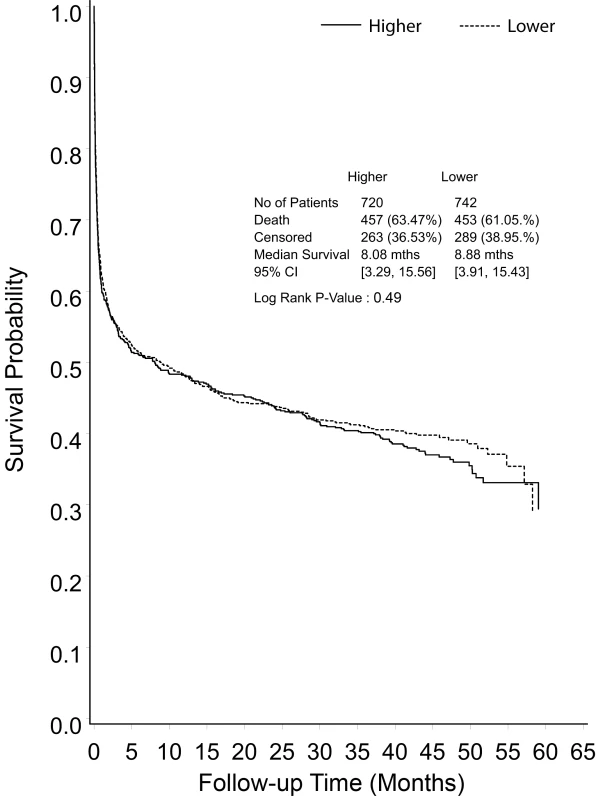
Median survival from randomization was 8.9 months in the lower intensity group and 8.1 months in the higher intensity group (RR 1.04, 95% CI 1.12, p = 0.49) (Figure 2). Excluding deaths before day 90, mortality in the lower intensity group was 122 of 411 (29.7%) and in the higher intensity group was 136 of 399 (34.1%) (RR 1.15, 95% CI 0.94–1.40, p = 0.26) (Figure 3). Causes of death beyond day 90 were similar in the two groups (Table 2), with more deaths in the higher intensity group ascribed to infectious causes (22 versus 35 deaths, p = 0.05).
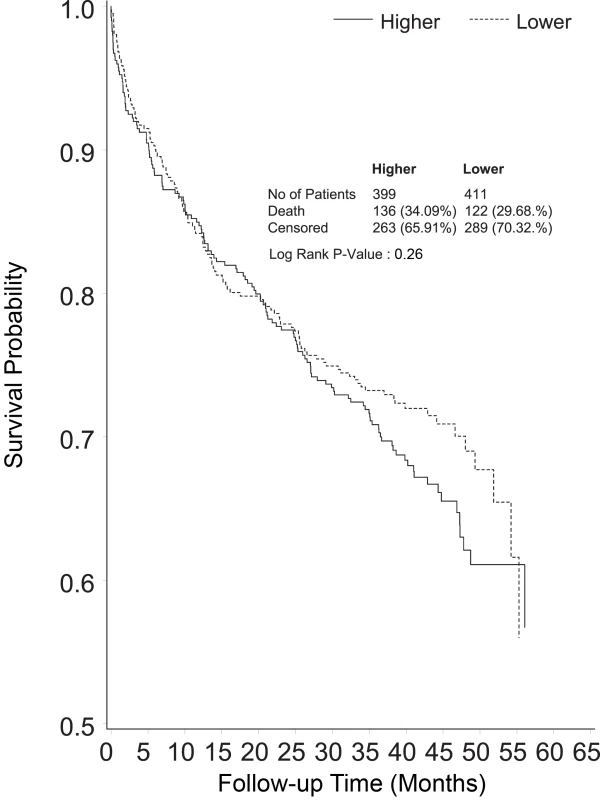
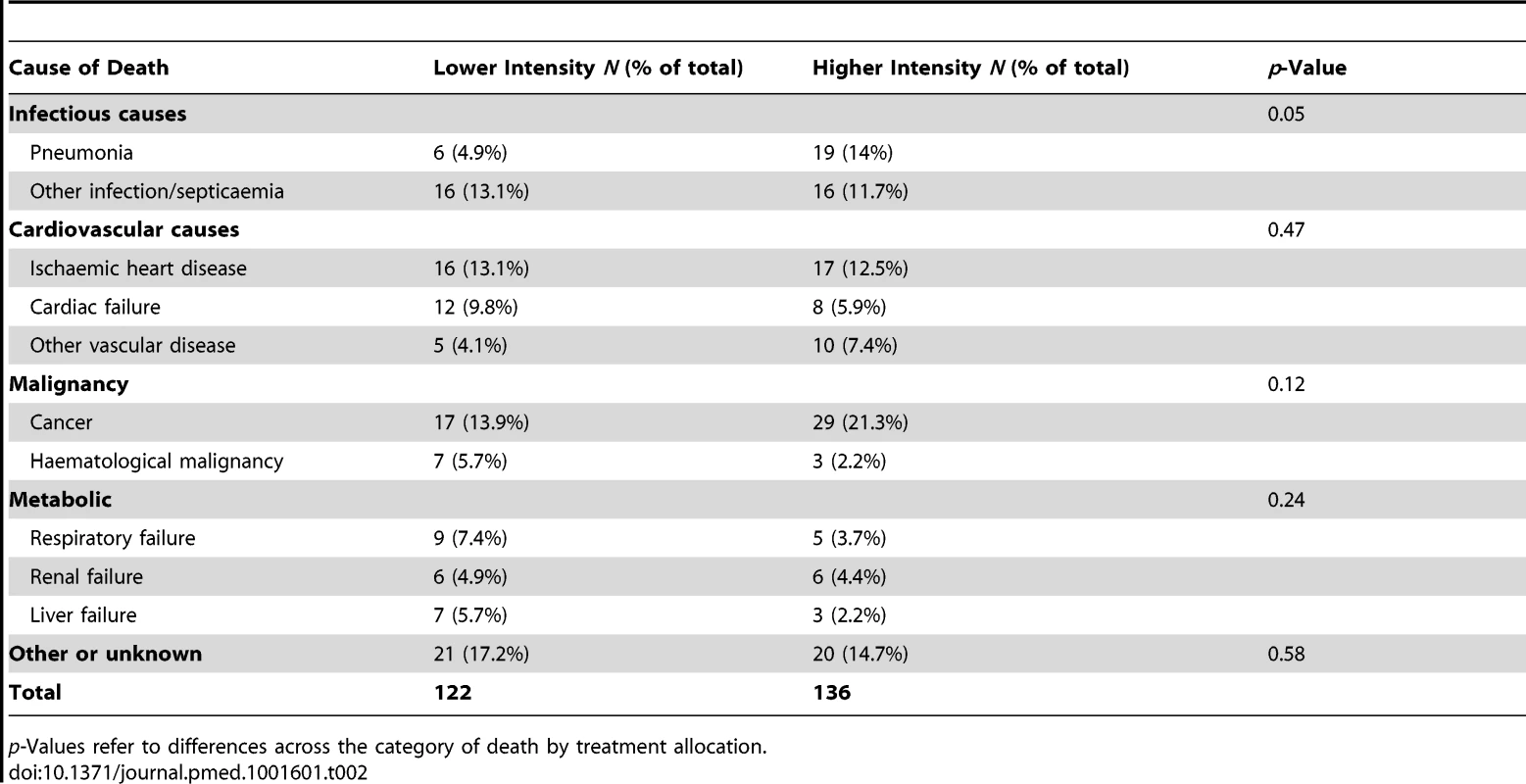
Forty-four patients (5.4% of those alive at day 90) were treated with maintenance dialysis (Figure 4), 21 of 411 (5.1%) in the lower intensity group and 23 of 399 (5.8%) in the higher intensity group (RR 1.12, 95% CI 0.63–2.00, p = 0.69). Thirty-four of these patients (77.2%) entered the maintenance dialysis program before day 90 following randomization, and ten (22.8%) entered after day 90. The cumulative incidence of the competing outcomes of death or treatment with chronic dialysis is illustrated in Figure 4. Of the 12 patients whose death was ascribed to renal failure, two had entered a dialysis program before death.
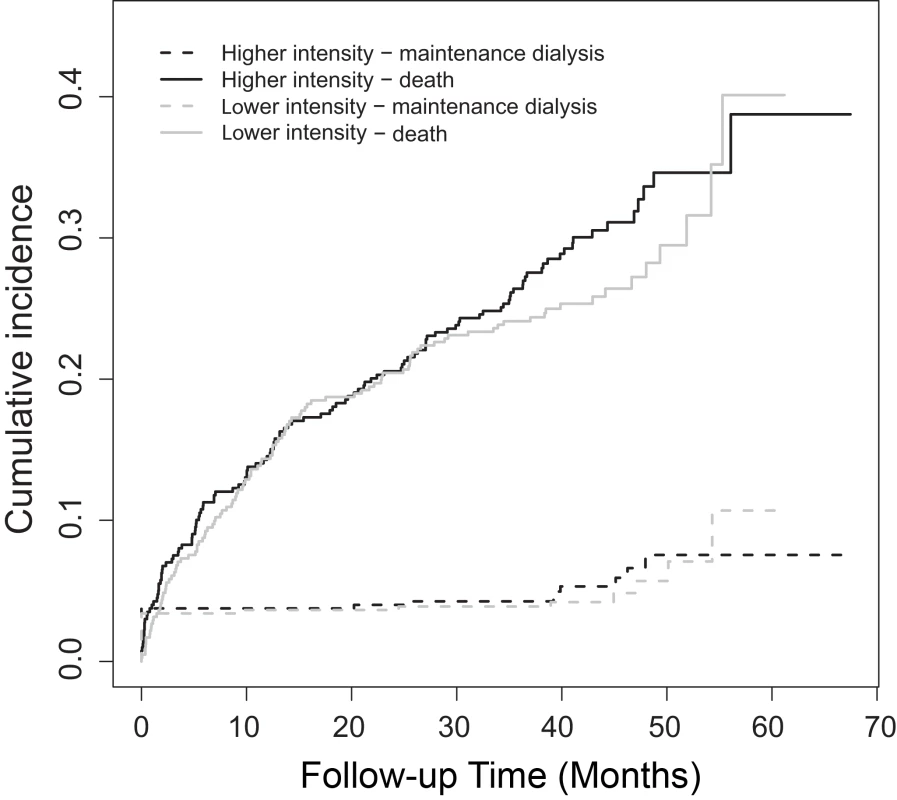
The tertiary outcomes are presented in Table 3. The mean eGFR in participating survivors was 58 ml/min/1.73 m2 and the prevalence of micro - or macro-albuminuria was 123/292 (42.1%), the values were similar in the two study groups (p = 0.72, and p = 0.48, respectively) (Table 3). Table 4 illustrates the cross tabulation of eGFR and albuminuria based upon recent guideline recommendations [22]. The only statistically significant difference between the two study groups in any of the tertiary outcomes was a higher diastolic blood pressure in the higher intensity group. In view of the number of outcomes analysed, this finding may be due to chance alone.
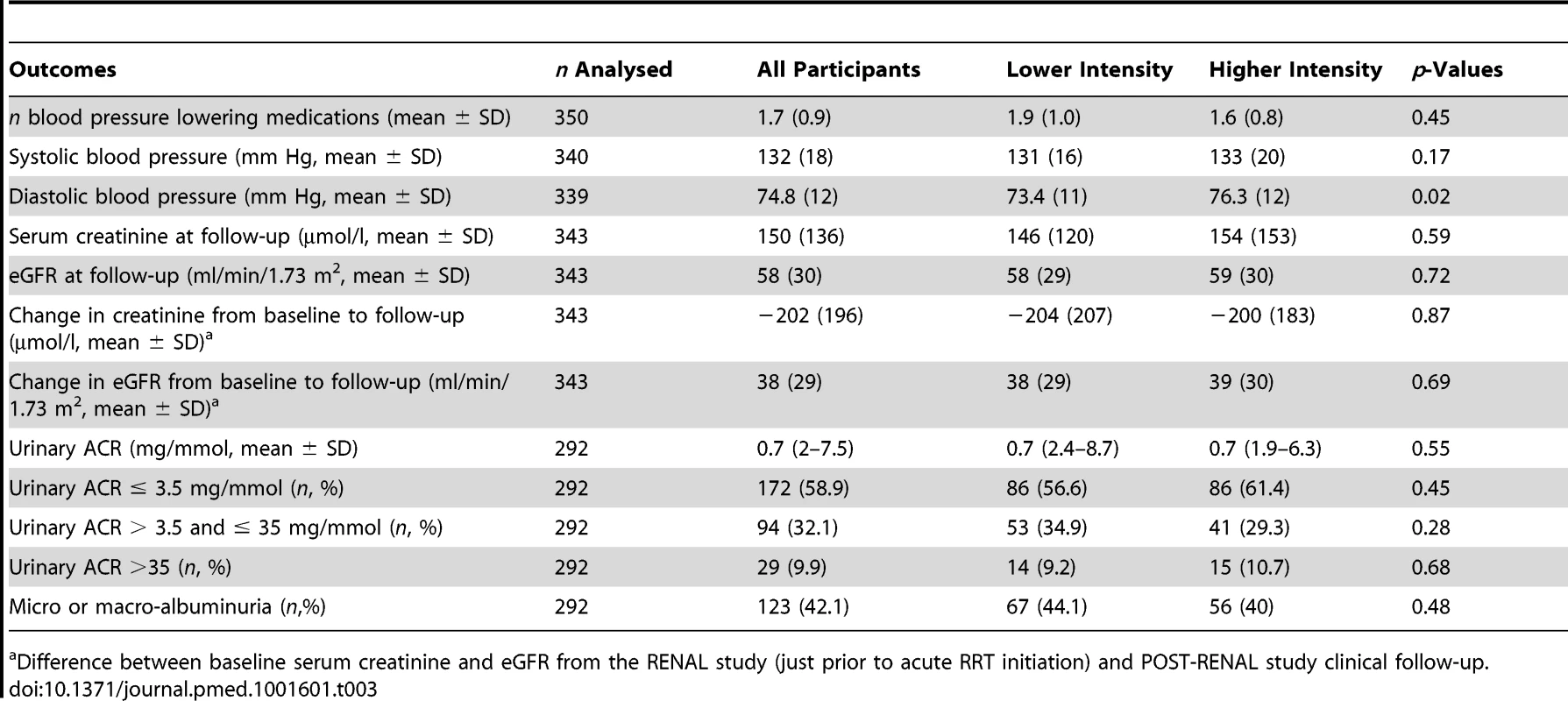
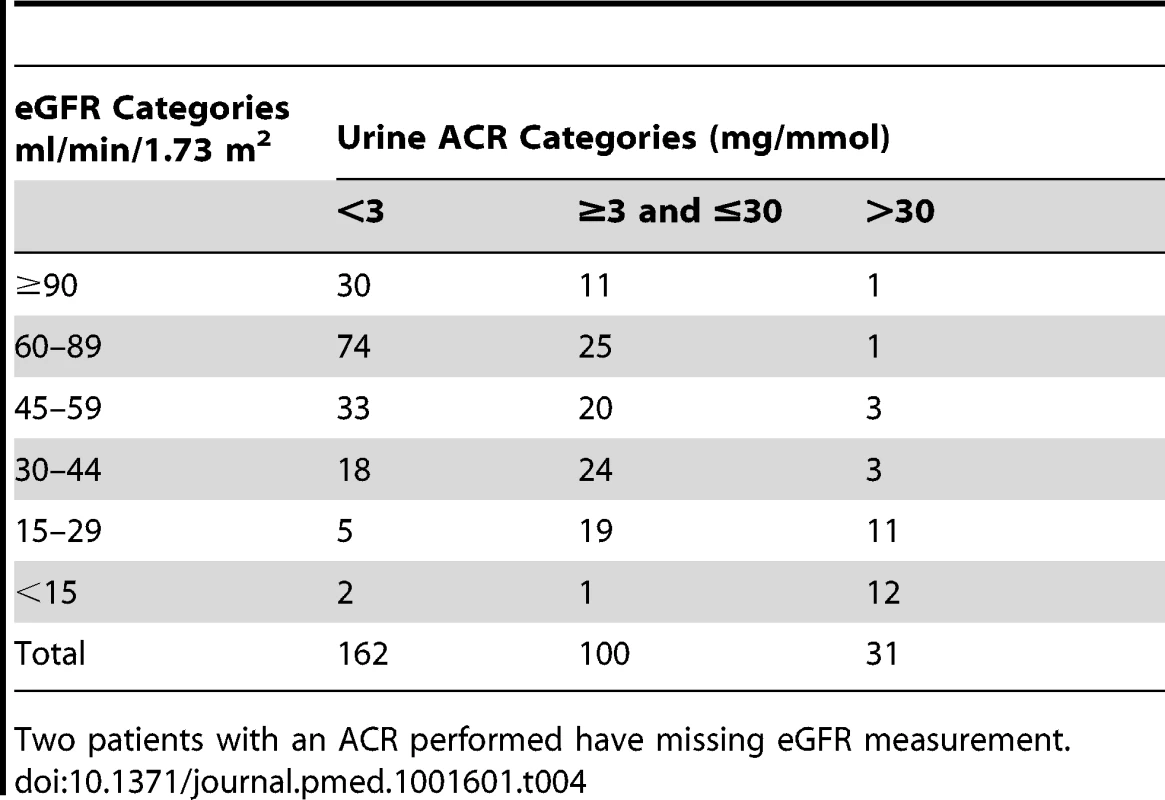
Quality of life in participating survivors, as measured using the EQ-5D composite index, was not different between the two study groups, with mean scores of 0.8 in the lower intensity group and 0.7 in the higher intensity group (SD = 0.3, p = 0.70) (Table S2). The SF-12 physical composite scores (mean ± SD, lower intensity 41.1±12 versus higher intensity 49.8±11, p = 0.34) and the SF-12 mental composite scores (49.6±12 versus 49.4±11, p = 0.89) among survivors were not different between the two study treatments.
Multivariate Predictors of Long-Term Mortality
Results of the univariate Cox modelling of the long-term mortality from randomization are presented in Table S3. The results of the multivariate Cox models are summarized in Figure 5 and Table 5. Increasing age of participants, divided using quartiles with the lowest age group (<56 years at randomization) as the reference, revealed incremental increases in mortality with age. After adjustment for other variables in the multivariate model, patients <56 years of age at randomization had a mortality of 48% at 3.5 years, compared to 71% in those aged >76 years (Figure 5). Other baseline variables that were statistically significant predictors of mortality on multivariate modelling were APACHE III score and serum creatinine at randomization. Study treatment intensity did not influence mortality.
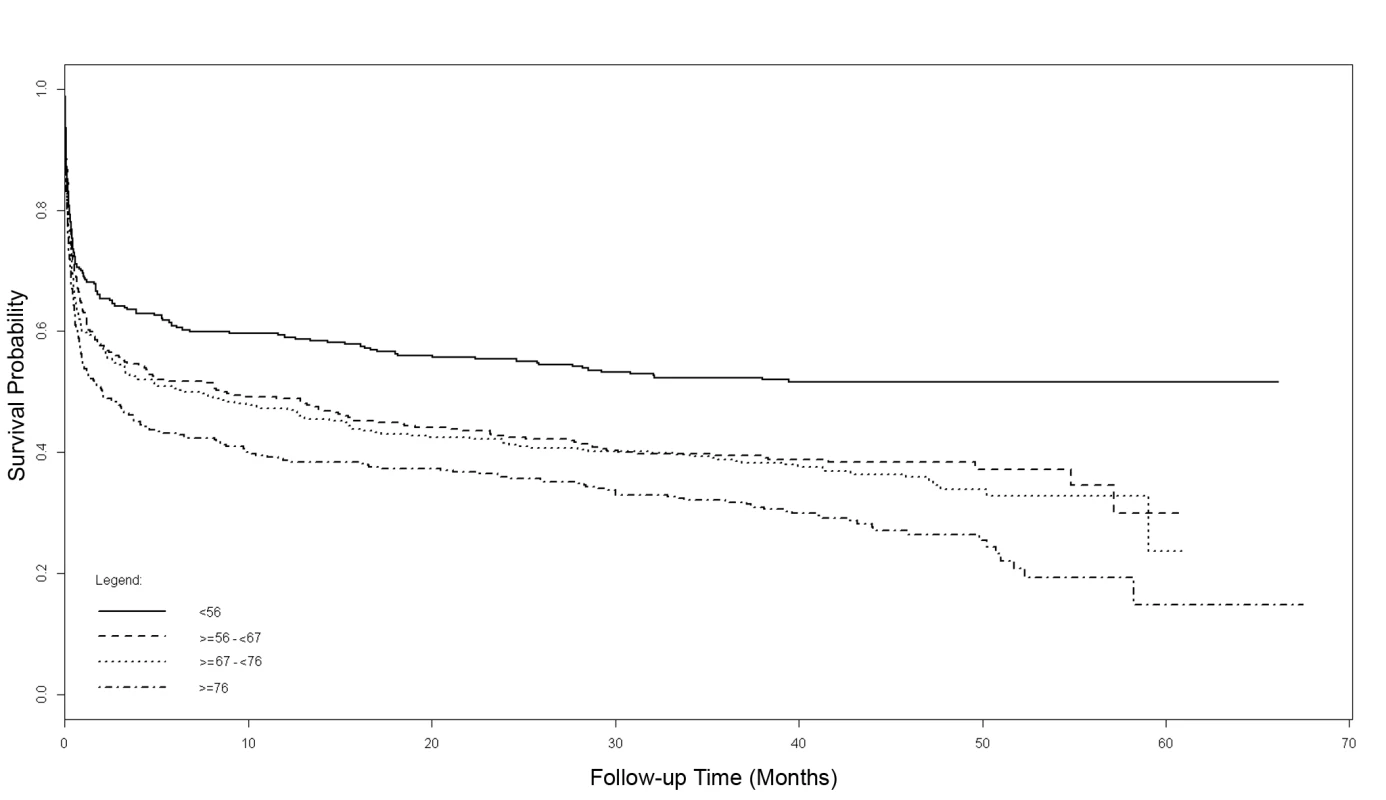

Discussion
Statement of Key Findings
We conducted an extended follow-up of patients randomized to a large study of ICU patients requiring RRT for AKI to establish the long-term mortality rate, the need for maintenance dialysis, prevalence of renal dysfunction, and the quality of life among survivors. We found that patients with AKI treated with RRT in the ICU were at high risk of dying during the 3.5-year follow-up period; overall 31.9% of those surviving to 90 days died during the extended follow-up period. The risk of dying was much greater than the risk of entering a maintenance dialysis program, with neither outcome being influenced by the use of a higher intensity of RRT. The rate of albuminuria in survivors was substantial, despite relative preservation of renal function.
Relationship to Existing Literature
Existing data on the long-term consequences of an episode of AKI are largely derived from administrative or disease specific cohorts [10],[23]. The absolute rates of CKD development and mortality reported from these studies have been highly variable [11], likely reflecting the different study designs and selection criteria, with pooled rates of 25.8 per 100 person years and 16.8 per 100 person years, respectively. The pooled relative risks from these studies, compared to non-AKI patients, of any CKD development following an episode of AKI was 8.8, for the development of end-stage kidney disease was 3.1, and for mortality was 2.0 [11]. The nature of these studies and their reporting has contributed to a perception that the risk of renal disease progression should be of primary concern in such patients. Our findings differ from many of these reports and these discrepancies are likely to be due to differences in the populations studied and the methodologies used. In particular, previous reports have not specifically targeted patients with AKI requiring RRT in the ICU, and such patients are at greater risk of dying compared with general hospital patients with AKI, as shown in a Swedish study of similar patients [23].
The paucity of prospective data has also limited our understanding of the natural history of AKI. Independent of eGFR, chronic proteinuria is a risk factor for death, cardiovascular disease, and the later requirement for dialysis [24],[25]. However, the prevalence of this risk factor following an episode of AKI has remained uncertain. Data from a broader population in Australia report a prevalence of proteinuria of 2.4% in the entire population that increases to 6.6% in those over 65 years of age [26]. Data from the National Health and Nutrition Examination Surveys cite a prevalence of 9.5% for albuminuria [27], and further data from a provincial laboratory registry in Canada report a prevalence of 25% using the ACR [28]. The degree of proteinuria in our study population prior to their renal injury is not known, but these other reports would suggest it is likely to be substantially less than the rate seen after the AKI in our study. Using recent classifications of CKD that include both eGFR and proteinuria to predict future risk of events [28], 13% of the survivors in our study population are in the highest risk group for death or renal functional decline.
The quality of life of survivors following treatment with RRT for AKI in the ICU has been described in a limited number of centres or shortly following the index hospitalization. Delannoy and colleagues [29] reported quality of life at six months following hospitalisation in seven centres; their results are consistent with ours, with very similar SF-12 physical and mental composite scores. When compared to a general population cohort with an eGFR < 60 ml/min/1.73 m2 in the Australian Diabetes, Obesity and Lifestyle Study [30], the SF-12 physical and mental component scores in our patients were similar. The EQ-5D composite scores in our severe AKI survivors most closely approximate those seen in renal transplant recipients [31].
Implications of Study Findings
Our study highlights the increased long-term risk of death associated with AKI treated with RRT in an ICU. Only one-third of randomized patients were alive 3.5 years later, a lower survival than that seen in recognised high mortality conditions such as the acute respiratory distress syndrome [32]. Although, in our patients the risk of subsequent maintenance dialysis dependence is low, almost half have evidence of significant proteinuria, portending further risk in the years to come. These findings support the view that survivors of AKI are at increased risk and that closer surveillance may be justified. In addition, our findings suggest that chronic proteinuria reduction strategies, which have shown benefit in some patient groups with proteinuria, may warrant investigation as a therapeutic intervention.
Study Strengths and Limitations
The strength of these findings lies in the prospective nature of the study along with the scale and completeness of long-term follow-up. The design allows for greater precision in estimates of absolute risk and enhances the clinical applicability of the findings whilst avoiding potential bias from retrospective selection of the study cohort. However, a further consequence of such a study design is that the findings from a randomized trial are not always generalizable to other patient populations, so caution should be applied in extrapolating these findings from an ICU cohort to other patients with AKI. In addition, while data linkage has allowed near complete follow-up of mortality and maintenance dialysis outcomes, the clinical and biochemical outcomes were only available for a consenting sub-group that might not be representative of the broader cohort.
Summary
In a large cohort of patients with AKI randomized to differing doses of continuous RRT in the ICU, the increased risk of death continues well beyond hospital discharge and is not altered by increased intensity of dialysis. The proportion of patients entering a maintenance dialysis program is small but there is a high prevalence of proteinuria amongst survivors suggesting significant ongoing risk of chronic kidney disease and mortality.
Supporting Information
Zdroje
1. AliT, KhanI, SimpsonW, PrescottG, TownendJ, et al. (2007) Incidence and outcomes in acute kidney injury: a comprehensive population-based study. J Am Soc Nephrol 18 : 1292–1298.
2. BagshawSM, GeorgeC, BellomoR (2007) Changes in the incidence and outcome for early acute kidney injury in a cohort of Australian intensive care units. Crit Care 11: R68.
3. CerdaJ, LameireN, EggersP, PannuN, UchinoS, et al. (2008) Epidemiology of acute kidney injury. CJASN 3 : 881–886.
4. UchinoS, KellumJA, BellomoR, DoigGS, MorimatsuH, et al. (2005) Acute renal failure in critically ill patients: a multinational, multicenter study. JAMA 294 : 813–818.
5. WaldR, QuinnRR, LuoJ, LiP, ScalesDC, et al. (2009) Chronic dialysis and death among survivors of acute kidney injury requiring dialysis. JAMA 302 : 1179–1185.
6. LoLJ, GoAS, ChertowGM, McCullochCE, FanD, et al. (2009) Dialysis-requiring acute renal failure increases the risk of progressive chronic kidney disease. Kidney Int 76 : 893–899.
7. ChoiAI, LiY, ParikhC, VolberdingPA, ShlipakMG (2010) Long-term clinical consequences of acute kidney injury in the HIV-infected. Kidney Int 78 : 478–485.
8. NewsomeBB, WarnockDG, McClellanWM, HerzogCA, KiefeCI, et al. (2008) Long-term risk of mortality and end-stage renal disease among the elderly after small increases in serum creatinine level during hospitalization for acute myocardial infarction. Arch Intern Med 168 : 609–616.
9. IshaniA, XueJL, HimmelfarbJ, EggersPW, KimmelPL, et al. (2009) Acute kidney injury increases risk of ESRD among elderly. J Am Soc Nephrol 20 : 223–228.
10. IshaniA, XueJL, HimmelfarbJ, EggersPW, KimmelPL, et al. (2009) Acute Kidney Injury Increases Risk of ESRD among Elderly. J Am Soc Nephrol 20 : 223–228.
11. CocaSG, SinganamalaS, ParikhCR (2012) Chronic kidney disease after acute kidney injury: a systematic review and meta-analysis. Kidney Int 81 : 442–448.
12. JunM, HeerspinkHJ, NinomiyaT, GallagherM, BellomoR, et al. (2010) Intensities of renal replacement therapy in acute kidney injury: a systematic review and meta-analysis. Clin J Am Soc Nephrol 5 : 956–963.
13. BellomoR, CassA, ColeL, FinferS, GallagherM, et al. (2009) Intensity of continuous renal-replacement therapy in critically ill patients. N Engl J Med 361 : 1627–1638.
14. Renal Study Investigators (2008) BellomoR, CassA, ColeL, FinferS, et al. (2008) Design and challenges of the Randomized Evaluation of Normal versus Augmented Level Replacement Therapy (RENAL) Trial: high-dose versus standard-dose hemofiltration in acute renal failure. Blood Purificat 26 : 407–416.
15. LeveyAS, BoschJP, LewisJB, GreeneT, RogersN, et al. (1999) A more accurate method to estimate glomerular filtration rate from serum creatinine: a new prediction equation. Modification of Diet in Renal Disease Study Group. Ann Intern Med 130 : 461–470.
16. EuroQol—a new facility for the measurement of health-related quality of life. The EuroQol Group. Health Policy 16 : 199–208.
17. WareJJr, KosinskiM, KellerSD (1996) A 12-Item Short-Form Health Survey: construction of scales and preliminary tests of reliability and validity. Med Care 34 : 220–233.
18. BoneRC, BalkRA, CerraFB, DellingerRP, FeinAM, et al. (1992) Definitions for sepsis and organ failure and guidelines for the use of innovative therapies in sepsis. The ACCP/SCCM Consensus Conference Committee. American College of Chest Physicians/Society of Crit Care Med. Chest 101 : 1644–1655.
19. KnausWA, WagnerDP, DraperEA, ZimmermanJE, BergnerM, et al. (1991) The APACHE III prognostic system. Risk prediction of hospital mortality for critically ill hospitalized adults. Chest 100 : 1619–1636.
20. VincentJL, de MendoncaA, CantraineF, MorenoR, TakalaJ, et al. (1998) Use of the SOFA score to assess the incidence of organ dysfunction/failure in intensive care units: results of a multicenter, prospective study. Working group on “sepsis-related problems” of the European Society of Intensive Care Medicine. Crit Care Med 26 : 1793–1800.
21. GrayRJ (1988) A class of K-sample tests for comparing the cumulative risk incidence of a competing risk. Ann Stat 16 : 1141–1154.
22. Kidney Disease: Improving Global Outcomes (KDIGO) CKD Work Group (2013) KDIGO 2012 Clinical Practice Guideline for the Evaluation and Management of Chronic Kidney Disease. Kidney Int Suppl 3 : 1–150.
23. BellM, GranathF, SchonS, EkbomA, MartlingCR (2007) Continuous renal replacement therapy is associated with less chronic renal failure than intermittent haemodialysis after acute renal failure. Intensive Care Med 33 : 773–780.
24. KlausenK, Borch-JohnsenK, Feldt-RasmussenB, JensenG, ClausenP, et al. (2004) Very low levels of microalbuminuria are associated with increased risk of coronary heart disease and death independently of renal function, hypertension, and diabetes. Circulation 110 : 32–35.
25. AstorBC, MatsushitaK, GansevoortRT, van der VeldeM, WoodwardM, et al. (2011) Lower estimated glomerular filtration rate and higher albuminuria are associated with mortality and end-stage renal disease. A collaborative meta-analysis of kidney disease population cohorts. Kidney Int 79 : 1331–1340.
26. ChadbanSJ, BrigantiEM, KerrPG, DunstanDW, WelbornTA, et al. (2003) Prevalence of kidney damage in Australian adults: The AusDiab kidney study. J Am Soc Nephrol 14: S131–138.
27. CoreshJ, SelvinE, StevensLA, ManziJ, KusekJW, et al. (2007) Prevalence of chronic kidney disease in the United States. JAMA 298 : 2038–2047.
28. TonelliM, MuntnerP, LloydA, MannsBJ, JamesMT, et al. (2011) Using proteinuria and estimated glomerular filtration rate to classify risk in patients with chronic kidney disease: a cohort study. Ann Intern Med 154 : 12–21.
29. DelannoyB, FloccardB, ThiolliereF, KaakiM, BadetM, et al. (2009) Six-month outcome in acute kidney injury requiring renal replacement therapy in the ICU: a multicentre prospective study. Intensive Care Med 35 : 1907–1915.
30. ChowFY, BrigantiEM, KerrPG, ChadbanSJ, ZimmetPZ, et al. (2003) Health-related quality of life in Australian adults with renal insufficiency: a population-based study. Am J Kidney Diseases 41 : 596–604.
31. LiemYS, BoschJL, HuninkMG (2008) Preference-based quality of life of patients on renal replacement therapy: a systematic review and meta-analysis. Value Health 11 : 733–741.
32. AngusDC, ClermontG, Linde-ZwirbleWT, MusthafaAA, DremsizovTT, et al. (2006) Healthcare costs and long-term outcomes after acute respiratory distress syndrome: A phase III trial of inhaled nitric oxide. Crit Care Med 34 : 2883–2890.
Štítky
Interné lekárstvoČlánok vyšiel v časopise
PLOS Medicine
2014 Číslo 2
- Parazitičtí červi v terapii Crohnovy choroby a dalších zánětlivých autoimunitních onemocnění
- Myasthenia gravis: kombinace chirurgie a farmakoterapie jako nejefektivnější modalita?
- Statinová intolerance
- Vztah mezi statiny a rizikem vzniku nádorových onemocnění − metaanalýza
- Pleiotropní účinky statinů na kardiovaskulární systém
Najčítanejšie v tomto čísle
- Obstructive Sleep Apnea and Risk of Cardiovascular Events and All-Cause Mortality: A Decade-Long Historical Cohort Study
- Living Systematic Reviews: An Emerging Opportunity to Narrow the Evidence-Practice Gap
- Quantitative Measurement of Melanoma Spread in Sentinel Lymph Nodes and Survival
- Physicians as Fundraisers: Medical Philanthropy and the Doctor-Patient Relationship
